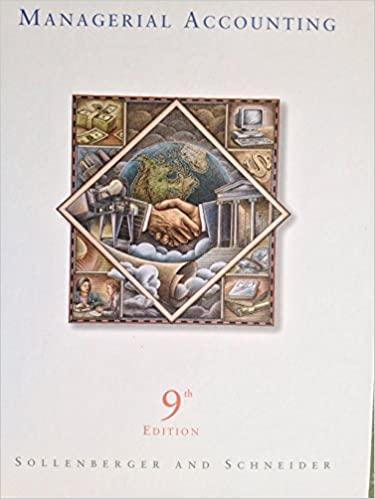Question A

Question 3 (22 marks) Zeta Ltd uses a single process to produce three joint products Alpha (A), Beta (B) and Gamma (G). 40,000 litres of A, 30,000 litres of B and 20,000 litres of G are produced from 100,000 litres of material put into the process The joint costs of processing a batch of raw materials are: Materials (100,000 litres) Conversion Costs $60,000 75,000 Sales and further processing information is as follows Alpha can be sold at split-off for $1.50/litre .Beta and Gamma require further processing before they can be sold The separable processing costs for Beta are $1.50/litre. Beta can then be sold for $3/litre The separable processing costs for Gamma are $2/litre. Gamma can then be sold for $4.25/litre o o During March, There were no inventories on hand at the end of February March sales were 30,000 litres of A, 28,000 litres of B and 16,000 litres of G the company processed 100,000 litres of raw mater ials Required: (a)Calculate the value of COGS for Alpha, Beta and Gamma for the March Income Statement if Zeta uses the Net Realisable Value (NRV) method to allocate the joint costs. (Be careful here- have you considered all of the costs?) (10 marks) (b)Should management use the unit cost information that results from the application of a joint cost allocation method, to evaluate the profitability of the individual joint products? Why or why not? Assume that an individual joint product is found to be unprofitable on this evaluation, should management drop the product? Briefly explain (3 marks) (c) (i) The CFO is considering the classification of the company's products. Briefly explain the difference between a joint product and a by product? (2 marks) (ii) Assume that Alpha has been reclassified as a by-product not a joint product. If Zeta allocates joint costs using the physical measures method, and uses the production method for the recognition of the by-product Alpha, calculate the joint cost allocation toeach product (3.5 marks) (d)Suppose now Alpha can be processed further into Super-A through an additional process costing $12,000. Per batch of raw materials (100,000 litres of input) 35,000 litres of Super-A can be produced. After further processing, Super-A can sell for $2.20/litre. Would the company be better or worse off by further processing Alpha into Super-A? By how much? Show calculations to support your answer (3.5 marks) Question 3 (22 marks) Zeta Ltd uses a single process to produce three joint products Alpha (A), Beta (B) and Gamma (G). 40,000 litres of A, 30,000 litres of B and 20,000 litres of G are produced from 100,000 litres of material put into the process The joint costs of processing a batch of raw materials are: Materials (100,000 litres) Conversion Costs $60,000 75,000 Sales and further processing information is as follows Alpha can be sold at split-off for $1.50/litre .Beta and Gamma require further processing before they can be sold The separable processing costs for Beta are $1.50/litre. Beta can then be sold for $3/litre The separable processing costs for Gamma are $2/litre. Gamma can then be sold for $4.25/litre o o During March, There were no inventories on hand at the end of February March sales were 30,000 litres of A, 28,000 litres of B and 16,000 litres of G the company processed 100,000 litres of raw mater ials Required: (a)Calculate the value of COGS for Alpha, Beta and Gamma for the March Income Statement if Zeta uses the Net Realisable Value (NRV) method to allocate the joint costs. (Be careful here- have you considered all of the costs?) (10 marks) (b)Should management use the unit cost information that results from the application of a joint cost allocation method, to evaluate the profitability of the individual joint products? Why or why not? Assume that an individual joint product is found to be unprofitable on this evaluation, should management drop the product? Briefly explain (3 marks) (c) (i) The CFO is considering the classification of the company's products. Briefly explain the difference between a joint product and a by product? (2 marks) (ii) Assume that Alpha has been reclassified as a by-product not a joint product. If Zeta allocates joint costs using the physical measures method, and uses the production method for the recognition of the by-product Alpha, calculate the joint cost allocation toeach product (3.5 marks) (d)Suppose now Alpha can be processed further into Super-A through an additional process costing $12,000. Per batch of raw materials (100,000 litres of input) 35,000 litres of Super-A can be produced. After further processing, Super-A can sell for $2.20/litre. Would the company be better or worse off by further processing Alpha into Super-A? By how much? Show calculations to support your answer (3.5 marks)







